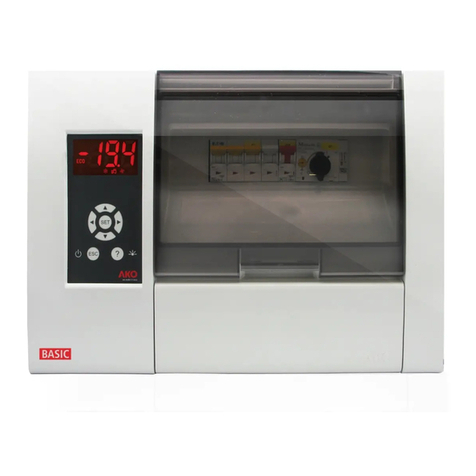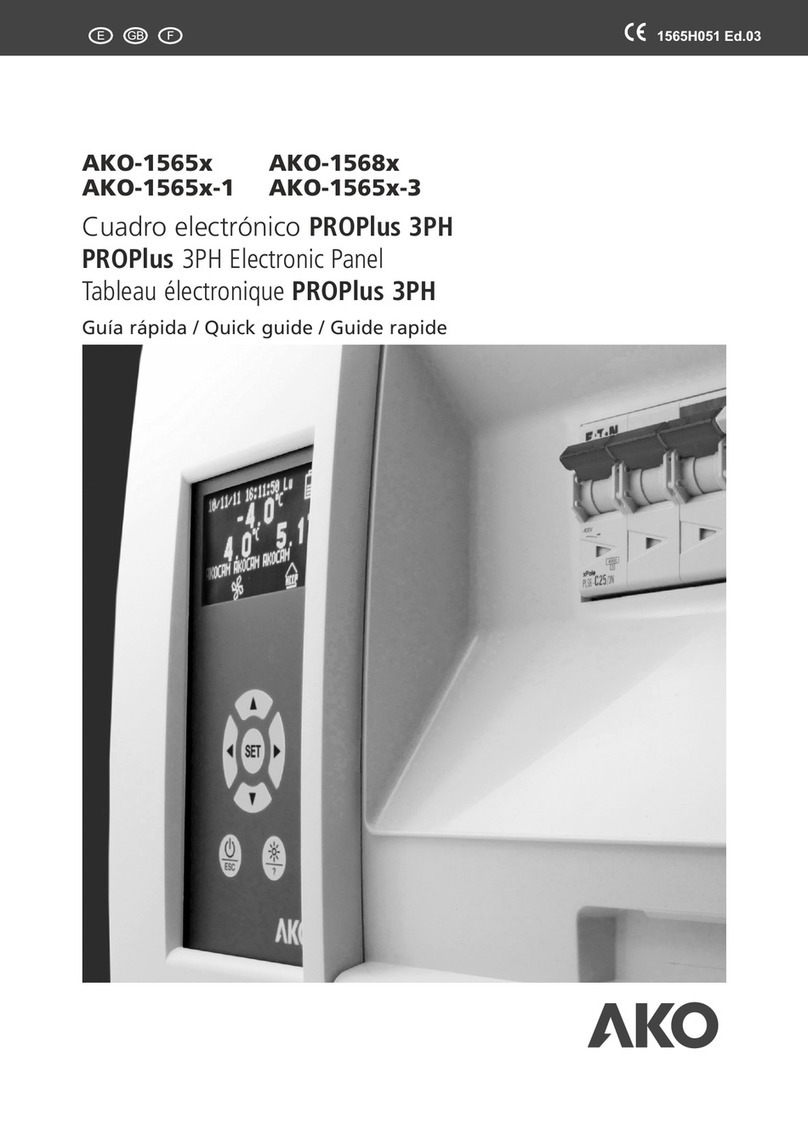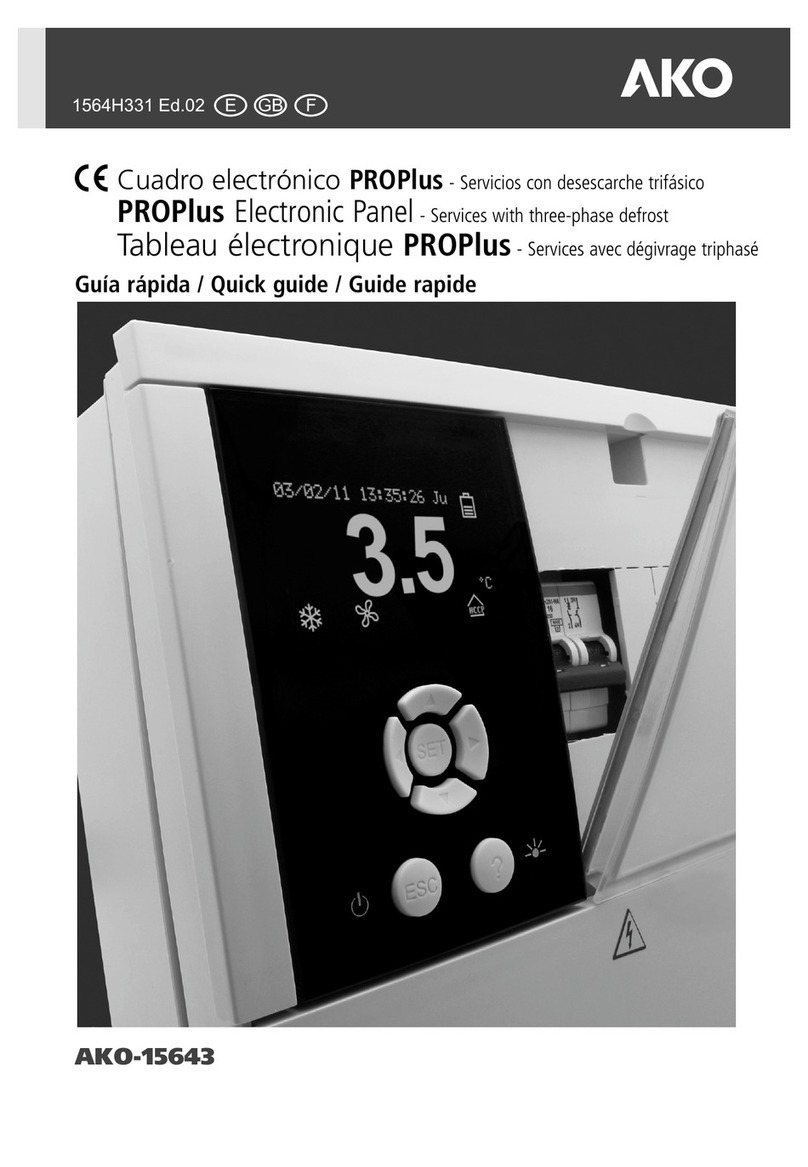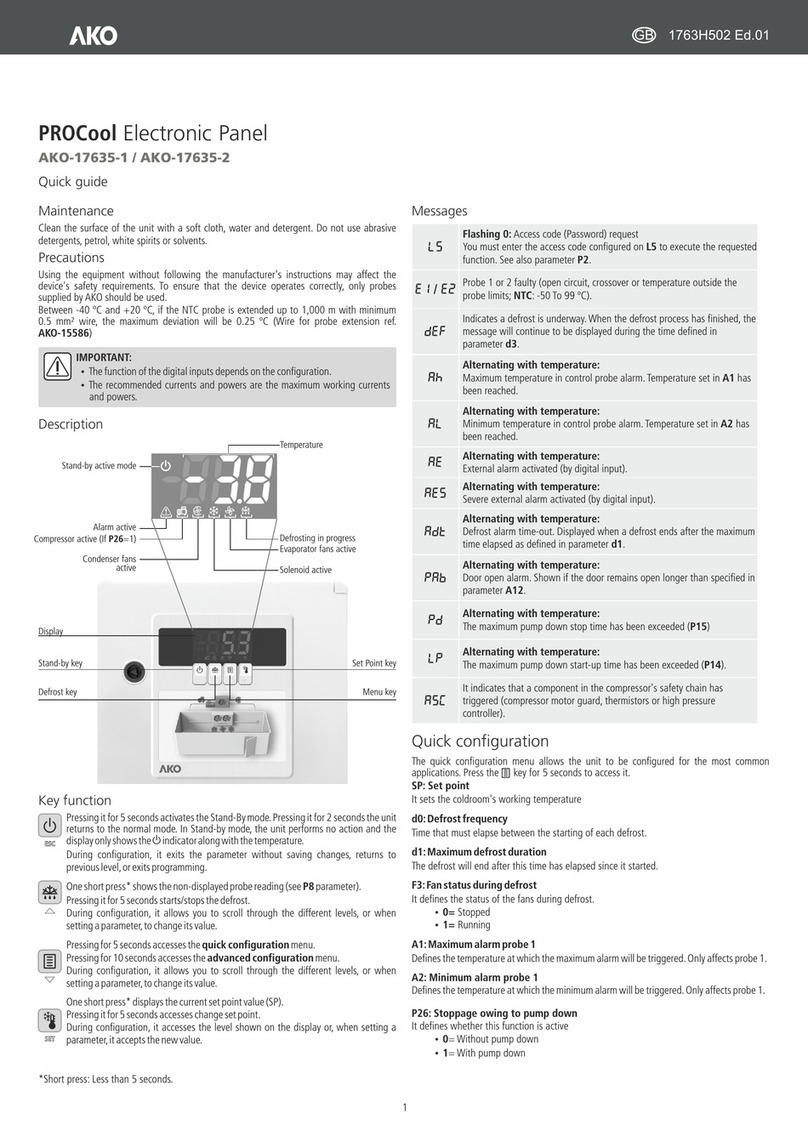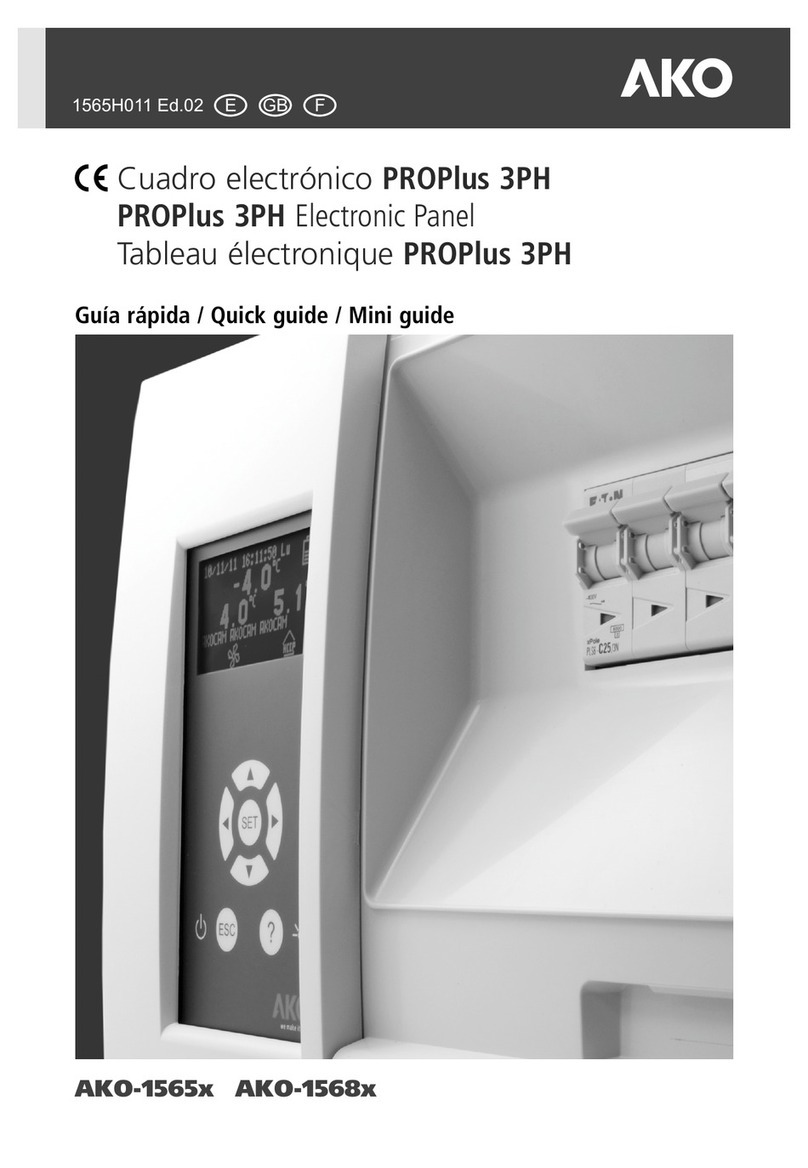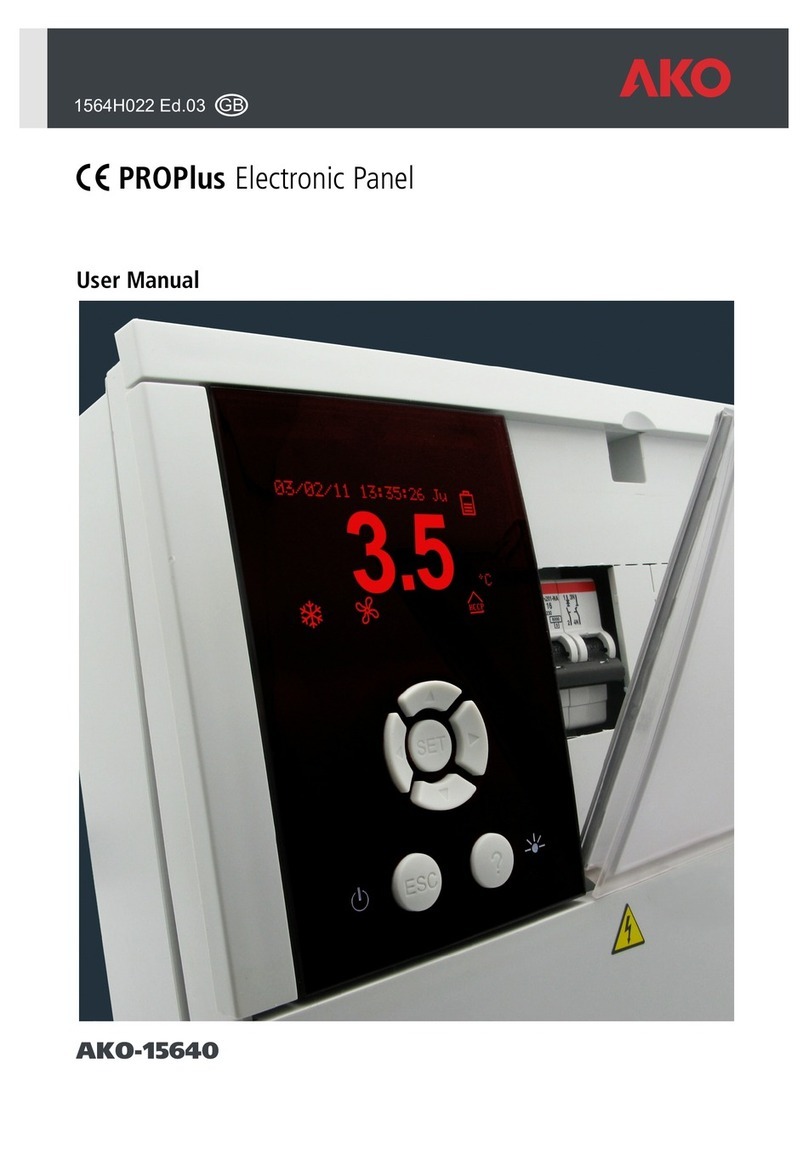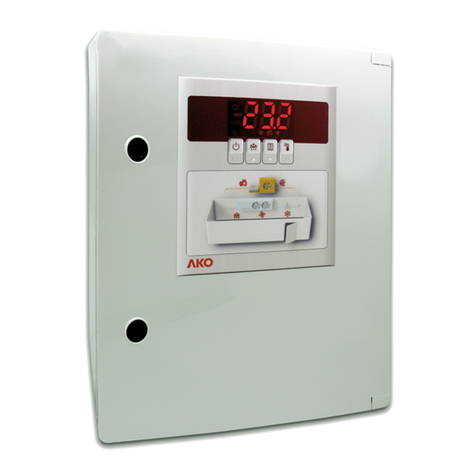
5- Description of Parameters and Messages
Values in the Def. column are factory-set.
NOTE: When time parameters are modified, the new values are applied when the current cycle
is completed. To apply values immediately, switch the controller off and then on again.
Level 3 Description Values Mín. Def. Máx.
Level 2 DEFROST control
Level 3 Description Values Mín. Def. Máx.
Set temperature (SP) (no locks)
Probe 1 differential (Hysteresis)
Set Point upper limit
(It cannot be set above this value)
Set Point lower limit
(It cannot be set below this value)
Compressor protection delay type:
OFF/ON (From the last switch-off)
ON (At switch-on)
Compressor protection
delay time.
“COOL” (Compressor) relay time in ON
in event of faulty probe 1
(If 0, the relay is always OFF)
“COOL” (Compressor) relay time in OFF
in event of faulty probe 1
(If 0, the relay is always ON)
Compressor stops when opening door?
(NO= connected) (YES=disconnected)
(ºC/ºF)
(ºC/ºF)
(ºC/ºF)
(min.)
(ºC/ºF)
(min.)
(min.)
-40.0 0.0 320
0.1 1.0 20.0
-40.0 99.9 320
-40.0 -40.0 320
off/on off/on on
0 0 255
0 10 255
0 5 255
No No Yes
EH
Defrost type:
(Electrical heater) (Hot gas by-pass)
Message maximum duration
Time added at the end of defrost (min.) 0 5 255
Defrost final temperature on probe 2
If probe 2 is programmed
Defrost start-up on equipment switch-on:
Defrost start-up delay on equipment
switch-on
Signals if defrost ends due to maximum time
Drip time, compressor stops and FAN
relay off when defrost ends
(ºC/ºF) -40.0 8.0 99.9
No No Yes
(min.) 00255
No No Yes
(min.) 01255
Fre.
06120
030 255
Def.
Defrost count
(Frequency)
(Compressor operation sum)
(RTC: Real time clock)
Defrost frequency:
Elapsed time between 2 starts
Defrost maximum duration
Type of message during defrost:
(Current temperature display)
(Defrost start temperature display)
(Display DEFROST message)
Level 2 ALARM control (Visual)
Level 2 DIGITAL INPUTS
Level 3 Description Values Mín. Def. Máx.
Level 3 Description Values Mín. Def. Máx.
Probe 2 differential
Stop fans when compressor stops?
(NO= connected) (YES=disconnected)
Fans status during defrost
(Connected) (Disconnected)
Start-up delay after defrost
Operates if it is higher than Drip Time
Configuration of temperature alarms
(Relative to SP) (Absolute)
Stop fans if the door opens?
(No=Connected) (Yes=Disconnected)
Maximum alarm in probe 1
Minimum alarm in probe 1
Temperature Alarms Differential
Temperature alarm delay from moment at
which they should operate due to temperature
Temperature alarm delay
on start-up
Temperature alarm delay from
the end of a defrost
Temperature alarm delay from
digital input disabling
If programmed as “Door contact”
Temperature alarm delay from
digital input enabling
If programmed as “Door contact”
Alarm relay status
(Connected) (Disconnected)
Digital Input Nº1 configuration
(Disabled) (Door Contact)
(External alarm) (Severe external alarm)
(Remote defrost) (Remote Energy saving)
(AUX relay activation) (Low-pressure in)
Alarm delay of digital input N°1
(ºC/ºF) 0.1 1.0 20.0
No No Yes
Disc.
(min.) 03255
No No Yes
Rel.
(ºC/ºF) -40.0 50.0 320
(ºC/ºF) -40.0 50.0 320
(ºC/ºF) 0.1 1.0 20.0
(min.) 030 255
(min.) 00255
(min.) 0 0 255
(min.) 0 0 255
(min.) 0 0 255
Conn.
Dis.
(min.) 0 0 255
Level 3 Description Values Mín. Def. Máx.
Fans stop temperature by
probe 2. If probe 2 is programmed (ºC/ºF) -40.0 4.0 99.9
Level 2 FANS control (Evaporator)
Level 1 Menus and Description
Level 2 REFRIGERATION control (Compressor)
Level 2 AUX RELAY
Level 2 GENERAL STATUS
Level 3 Description Values Mín. Def. Máx.
Level 3 Description Values Mín. Def. Máx.
Polarity of digital input Nº1
(Normally open) (Normally closed)
Digital input N°2 configuration
(Disabled) (Door Contact)
(External alarm) (Severe external alarm)
(Remote defrost) (Remote Energy saving)
(AUX relay activation) (Low-pressure in)
Alarm delay of digital input N°2
Polarity of digital input Nº2
(Normally open) (Normally closed)
AUX relay configuration
(Disabled) (Activated by key)
(Activated by input) (Equal state of equipment)
(Second Defrost) (Pump down control)
Defrost 2 probe
(Disabled) (Probe 2) (Probe 3)
Defrost 2 maximum duration
Defrost 2 final temperature
Pump-down duration
Pump-down On delay
Access code (password) to
parameters and set point
NC.
Dis.
Dis.
Dis.
NC.
(min.) 0 0 255
(min.) 0 30 255
(sec.) 1180 1800
(sec.) 0 5 60
0099
Level 2 CONTINUOUS CYCLE
Level 3 Description Values Mín. Def. Máx.
(min.) 00255
Display mode (1 probe + clock) (1 probe + text)
(Connected probes + clock + text)
Temperature display unit
Decimal point
Delay of all functions on power supply switch on
Type of operation:
Not selectable (always cold)
Program version (Information)
Continuous cycle duration
Yes
ºC ºC ºF
Cold
(h.) 0 1 24
1PC
Allocation of password to Set Point
Initial parameters:
(YES, configure in “Def” and exit programming)
Register interval
Address for units with communication
Parameters transfer
(Disabled) (Send) (Receive)
Connected probes (Probe 1), (Probe 1 and 2)
(Probe 1 and 3) (Probe 1, 2 and 3)
Probe to be displayed
Dis.
No
No
01 255
(min.) 015 60
1 1 3
1
Level 2 ENERGY SAVING
Level 3 Description Values Mín. Def. Máx.
Level 2 HACCP
Level 3 Description Values Mín. Def. Máx.
Level 2 LANGUAGE
Level 3 Description Values Mín. Def. Máx.
Level 2 CLOCK
Level 3 Description Values Mín. Def. Máx.
Set Point during
energy saving
Duration of energy saving
Delay in registering a event after a temperature alarm
English
Date (Year Month Day)
Time (Week_Day Hour Minute)
Defrost 1 (Day Hour Minute)
Defrost 2 (Day Hour Minute)
Defrost 3 (Day Hour Minute)
Defrost 4 (Day Hour Minute)
Defrost 5 (Day Hour Minute)
Defrost 6 (Day Hour Minute)
Defrost 7 (Day Hour Minute)
Defrost 8 (Day Hour Minute)
Energy saving Start (Day Hour Minute)
(min.) 0 255
(h.) 0024
(ºC/ºF) -40.0 0320
0
-58.0 8.0 99.9
Probe setting (TEM at S1/REG at S3),
(TEM and REG at S3) (See table “Assignment of entries”) TEM
at S1
- 3 -
Access code (password) request to enter programming of parameters or Set Point
Indicates defrosting is in progress.
Flashing with temperature
Flashing with temperature
Flashing with temperature - Temperature of Probe 1 exceeds maximum Probe 1
Alarm parameter.
Flashing with temperature - Temperature of Probe 1 is below minimum
programmed Probe 1 Alarm parameter.
Flashing with temperature - Low-pressure pressostat error with compressor in
operation.
Probe 1, 2 or 3 failure (Open, crossed circuit; NTC: temp.> 110 ºC
or temp.<-55 ºC; PTC: temp.> 150 °C or temp.<-58 °C)
MESSAGES
ACCESS CODE
DEFROST
EXTERNAL ALARM
HIGH TEMP. ALARM
SEVERE EXT. ALARM
LOW TEMP. ALARM
LOW PRESSURE ALARM
PROBE 1, 2, or 3 ALARM
